2010 | OriginalPaper | Chapter
28. Benefits of Threshold Regression: A Case-Study Comparison with Cox Proportional Hazards Regression
Authors : Mei-Ling Ting Lee, G. A. Whitmore, Bernard Rosner
Published in: Mathematical and Statistical Models and Methods in Reliability
Publisher: Birkhäuser Boston
Activate our intelligent search to find suitable subject content or patents.
Select sections of text to find matching patents with Artificial Intelligence. powered by
Select sections of text to find additional relevant content using AI-assisted search. powered by
